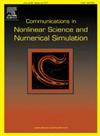Bifurcation sequences in the secular 3D planetary 3-Body problem: a geometric approach
IF 3.8
2区 数学
Q1 MATHEMATICS, APPLIED
Communications in Nonlinear Science and Numerical Simulation
Pub Date : 2025-09-19
DOI:10.1016/j.cnsns.2025.109324
引用次数: 0
Abstract
We implement the geometric method proposed in [14, 17, 21] to analytically predict the sequence of bifurcations leading to a change of stability and/or the appearance of new periodic orbits in the secular 3D planetary three body problem. Stemming from the analysis in [1], we examine various normal form models as regards the extent to which they lead to a phase space dynamics qualitatively similar as that in the complete system. For fixed total angular momentum, the phase space in Hopf variables is the 3D sphere, and the complete sequence of bifurcations of new periodic orbits can be recovered through formulas yielding the tangencies or degenerate intersections between the sphere and the surfaces of a constant second integral of motion of the normal form flow. In particular, we find the critical values of the second integral giving rise to pitchfork and saddle-node bifurcations of new periodic orbits in the system. This analysis renders possible to predict the most important structural changes in the phase space, as well as the emergence of new possible stable periodic planetary orbital configurations which can take place as the mutual inclination between the two planets is allowed to increase.
长期三维行星三体问题的分岔序列:几何方法
我们实现了[14,17,21]中提出的几何方法来解析预测导致长期三维行星三体问题稳定性变化和/或新周期轨道出现的分岔顺序。根据[1]中的分析,我们检查了各种范式模型,看看它们在多大程度上导致了与完整系统中质量相似的相空间动力学。对于固定的总角动量,Hopf变量中的相空间是三维球体,新周期轨道的完整分岔序列可以通过生成球体与常模流运动第二积分表面之间的切线或简并交点的公式来恢复。特别地,我们发现二阶积分的临界值引起了系统中新的周期轨道的干草叉分岔和鞍节点分岔。这种分析可以预测相空间中最重要的结构变化,以及随着两颗行星相互倾斜度的增加,可能出现的新的稳定周期行星轨道构型。
本文章由计算机程序翻译,如有差异,请以英文原文为准。
求助全文
约1分钟内获得全文
求助全文
来源期刊

Communications in Nonlinear Science and Numerical Simulation
MATHEMATICS, APPLIED-MATHEMATICS, INTERDISCIPLINARY APPLICATIONS
CiteScore
6.80
自引率
7.70%
发文量
378
审稿时长
78 days
期刊介绍:
The journal publishes original research findings on experimental observation, mathematical modeling, theoretical analysis and numerical simulation, for more accurate description, better prediction or novel application, of nonlinear phenomena in science and engineering. It offers a venue for researchers to make rapid exchange of ideas and techniques in nonlinear science and complexity.
The submission of manuscripts with cross-disciplinary approaches in nonlinear science and complexity is particularly encouraged.
Topics of interest:
Nonlinear differential or delay equations, Lie group analysis and asymptotic methods, Discontinuous systems, Fractals, Fractional calculus and dynamics, Nonlinear effects in quantum mechanics, Nonlinear stochastic processes, Experimental nonlinear science, Time-series and signal analysis, Computational methods and simulations in nonlinear science and engineering, Control of dynamical systems, Synchronization, Lyapunov analysis, High-dimensional chaos and turbulence, Chaos in Hamiltonian systems, Integrable systems and solitons, Collective behavior in many-body systems, Biological physics and networks, Nonlinear mechanical systems, Complex systems and complexity.
No length limitation for contributions is set, but only concisely written manuscripts are published. Brief papers are published on the basis of Rapid Communications. Discussions of previously published papers are welcome.
 求助内容:
求助内容: 应助结果提醒方式:
应助结果提醒方式:


